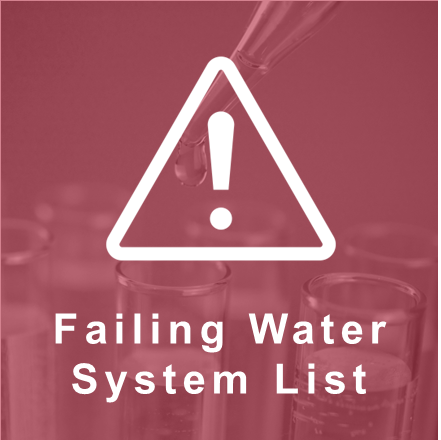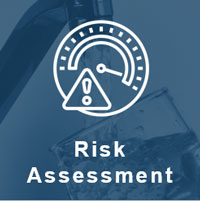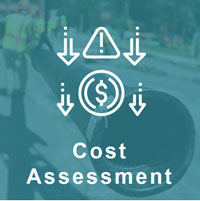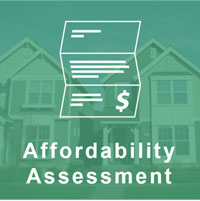
California Drinking Water Needs Assessment
In 2019, to advance the goals of the Human Right to Water “HR2W”, California passed Senate Bill 200, which enabled the State Water Board to establish the Safe and Affordable Funding for Equity and Resilience (SAFER) Program. Foremost among the tools created for SAFER is the Safe and Affordable Drinking Water Fund. The Fund provides up to $130 million per year through 2030 to enable the State Water Board to develop and implement sustainable solutions for underperforming drinking water systems. The annual Fund Expenditure Plan prioritizes projects for funding, documents past and planned expenditures, and is “based on data and analysis drawn from the drinking water Needs Assessment.”
For more information on SAFER, visit the Safe and Affordable Fund for Equity and Resilience (SAFER) website.
2025 Needs Assessment

2025 Drinking Water Needs Assessment Results
- Final Report
- Executive Summary: English | Spanish
- Fact Sheet
- Request Water System Data Change
2025 Risk Assessment for Public Water Systems
2025 Risk Assessment for State Small Water Systems and Domestic Wells
2025 Cost Assessment
The 2025 Needs Assessment does not include an updated Cost Assessment or Funding Gap Analysis, as the changes in the number of Failing and At-Risk systems were minimal and did not necessitate an update. For comprehensive details on the 2024 Cost Model, please refer to the Cost Assessment available in the 2024 Folder under Archives.
Dashboards
- SAFER Dashboard (Failing & At-Risk Systems)
- State Small Water System & Domestic Well Risk Assessment Dashboard
- Aquifer Risk Map
Datasets
Archives
2024 Drinking Water Needs Assessment Results
- Final Report
- Executive Summary: English | Spanish
- Fact Sheet
- Risk Assessment Results and Methodology
- Cost Assessment & Funding Gap Analysis
- Methodology
- Attachment: Cost Assessment Data and Results
- Supplemental Appendix: Physical Consolidation Cost Estimate Methodology
- Supplemental Appendix: Centralized Treatment Cost Estimate Methodology
- Supplemental Appendix: Decentralized Treatment Cost Estimate Methodology
- Supplemental Appendix: Additional Long-Term Modeled Solutions Cost Estimate Methodology
- Supplemental Appendix: Interim Solutions Cost Estimate Methodology
- Funding GAP Analysis
- Risk Assessment Methodology for State Small Water Systems & Domestic Wells
- Affordability Assessment Results and Methodology
2023 Drinking Water Needs Assessment Results
2022 Drinking Water Needs Assessment Results
- Final Report
- Risk Assessment Results and Methodology
- Risk Assessment for State Small Water Systems and Domestic Wells Results and Methodology
- Cost Assessment Results and Methodology
- Affordability Assessment Results and Methodology
2021 Drinking Water Needs Assessment Results
- Full Final Report
- Risk Assessment for State Small Water Systems and Domestic Well Results and Methodology
- Cost Assessment Results and Methodology
- Attachment C1: Geographic Information System and Database Methodologies
- Attachment C2: Kern County Case Study
- Attachment C3: Treatment Cost Methodology Details
- Attachment C4: Sustainability and Resiliency Assessment
- Attachment C5: Additional Cost Assessment Results and Regionalization Analysis
- Attachment D1: Supplemental Gap Analyses for the Safe and Affordable Drinking Water Fund (SADWF)
- Affordability Assessment Results and Methodology
- 2021 Needs Assessment Press Release: 04.09.2021
- 2021 Needs Assessment FAQs
- 04.13.2021 Presentation
- 04.13.2021 Webinar Recording
Needs Assessment Methodology Development
The State Water Board has been hosting public webinar workshops to provide opportunities for stakeholders to learn about and contribute to the development of the Needs Assessment methodologies. These methodologies will be refined over time, particularly as new information becomes available or as new regulatory changes occur.
Since 2017, the State Water Board has assessed water systems that fail to meet the goals of the Human Right to Water and maintains a list and map of these systems on its website. Systems that are on the Failing list are those that are out of compliance or consistently fail to meet primary drinking water standards. Systems that are assessed for meeting the Failing list criteria include Community Water Systems (CWSs) and non-transient non-community (NTNC) that serve schools and daycares. The Failing list criteria was expanded in April 2021 and may be refined over time.
- The Failing List is updated daily in the SAFER Dashboard
- Failing Criteria (Updated April 2021)
2024 Drinking Water Needs Assessment
- December 20, 2023: Proposed Updates for the 2024 Drinking Water Needs Assessment
- Public Notice: English │ Spanish
- White Paper
- Presentation
- Webinar Recording
2022 Drinking Water Needs Assessment
2021 Drinking Water Needs Assessment
State Board Updates
- 2019 State Board Update (08.20.19)
- 2018 State Board Update (03.20.18)
- 2017 State Board Update (02.22.17)
Additional Resources
Identifying small and medium public water systems and K-12 schools that are at-risk of failing to provide adequate safe drinking water. The State Water Board will be coordinating with Indian Health Services and U.S. EPA to develop and conduct a Risk Assessment for tribal water systems in California.
- February 3, 2023: Proposed Changes for the 2023 Needs Assessment
- Public Notices: English | Spanish
- White Paper
- Presentation
- Webinar Recording
- February 2, 2022: Proposed Changes for the 2022 Needs Assessment
- Public Notices: English | Spanish
- White Paper
- Presentation
- Webinar Recording 02-02-2022
- December 14, 2020: Risk Assessment 2.0 Webinar 4: Thresholds, Scores and Weights
- October 13, 2020: Risk Assessment 2.0 Webinar 3: Evaluation and Recommendation of Risk Indicators
- Public Notices: English | Spanish
- White Paper and Appendices: D1, D2, D3, D4
- Presentation
- Webinar Recording 10-13
- July 22, 2020: Risk Assessment 2.0 Webinar 2: Identifying Potential Risk Indicators
- Public Notices: English | Spanish
- Agenda
- White Paper
- Presentation
- Webinar Recording 7-22
- April 17, 2020: Risk Assessment 2.0 Webinar 1: Methods for Determining “At-Risk” Public Water Systems, Domestic Wells, and State Small Water Systems
- July 11, 2019
- Agenda
- Webcast Recording
- Presentation PDFs:
- State Water Board Introduction
- State Water Board Financial Pilot Study
- Rural Community Assistance Corporation (RCAC)
- California Rural Water Association (CRWA)
- University of California, Davis
- Office of Environmental Health Hazard Assessment (OEHHA)
- Pacific Institute Presentation
- University of North Carolina, Environmental Finance Center
- University of California, Los Angeles-Luskin Center for Innovation
Identifying state small water systems and regions where domestic wells are at-risk of failing to provide adequate safe drinking water.
- February 3, 2023: Proposed Changes for the 2023 Needs Assessment
- Public Notices: English | Spanish
- White Paper
- Presentation
- Webinar Recording
- February 2, 2022: Proposed Changes for the 2022 Needs Assessment
- Public Notices: English | Spanish
- White Paper
- Presentation
- Webinar Recording 02-02-2022
- October 20, 2021: SAFER Aquifer Risk Map Proposed Updates
- Public Notices: English | Spanish
- Webinar Recording
- Summary of Updates
- November 4, 2020: SAFER Aquifer Risk Map Board Presentation
- October 9, 2020: SAFER Aquifer Risk Map: At-Risk Domestic Wells and State Small Systems Public Webinar
- Public Notice: English | Spanish
- Presentation
- July 22, 2020: SAFER Webinar Series 2: At Risk Public Water Systems (PM session for Domestic Wells & State Smalls)
- Public Notices: English | Spanish
- Agenda
- White Paper
- Presentation
- Webinar Recording 7-22
- April 17, 2020: Methods for Determining “At-Risk” Public Water Systems, Domestic Wells, and State Small Water Systems
- January 18, 2019: Domestic Wells Workshop
- Agenda
- Abstracts
- Webcast Recording
- Presentation PDFs:
- State Board Introduction, J. Borkovich and D. Polhemus
- USGS GAMA Program, M. Fram
- State Board GAMA Program, D. Bellan
- Legacy Well Construction, R.M. Gailey
- CV-SALTS Technical Approaches, V. Kretsinger
- Modeling Nitrate in Central Valley, K. Ransom
- Domestic Well Data in the Central Valley, R. Pauloo
- Drinking Water Vulnerability Screening Tool, C. Pace
- Tulare Lake Basin GIS Collaborative, M. Hickey
Determining the costs related to the implementation of interim and longer-term solutions for systems on the Human Right to Water list and At-Risk systems.
- December 20, 2023: Proposed Updates for the 2024 Drinking Water Needs Assessment
- Public Notice: English │ Spanish
- White Paper
- Presentation
- Webinar Recording
- December 20, 2023: Proposed Updates to the Drinking Water Cost Assessment Model – Workshop 3: Other Essential Infrastructure, Administrative Needs, and Interim Solutions
- Public Notice: English │ Spanish
- White Paper
- Presentation
- Webinar Recording
- October 5, 2023: Proposed Updates to the Drinking Water Cost Assessment Model – Workshop 2: Modeled Treatment Analysis
- Public Notice: English │ Spanish
- White Paper
- Presentation
- Webinar Recording
- July 14, 2023: Proposed Updates to the Drinking Water Cost Assessment Model – Workshop 1: Physical Consolidation Analysis
- Public Notices: English │ Spanish
- White Paper
- Presentation
- Webinar Recording
- August 4, 2022: Proposed Changes for the Cost Assessment
- Public Notices: English | Spanish
- White Paper
- Presentation
- Webinar Recording
- February 2, 2022: Proposed Changes for the 2022 Needs Assessment
- Public Notices: English | Spanish
- White Paper
- Presentation
- Webinar Recording 02-02-2022
- February 26, 2021: SAFER: Cost Assessment Model Preliminary Results and Gap Analysis Webinar
- November 20, 2020: Cost Estimate: In-Depth Cost Methodology Discussion Webinar
- Public Notices: English | Spanish
- White Paper
- Presentation
- Webinar Recording
- August 28, 2020: Cost Estimate: Overview of Approach and Update
- May 10, 2019: Cost Analysis Workshop
- Public Notice
- Agenda
- Webcast Recording
- Presentation PDFs:
Identifying community water systems that serve disadvantaged communities that must charge their customers’ fees that exceed the affordability threshold established by the State Water Board in order to provide adequate safe drinking water.
- February 3, 2023: Proposed Changes for the 2023 Needs Assessment
- Public Notices: English | Spanish
- White Paper
- Presentation
- Webinar Recording
- November 1, 2022 Public Webinar on SAFER Affordability Workshop 3
- Public Notices: English | Spanish
- White Paper
- Presentation
- Webinar Recording
- September 20, 2022 Public Webinar on SAFER Affordability Workshop 2
- August 8, 2022 Public Webinar on SAFER: Affordability Workshop 1
- Public Notices: English | Spanish
- Presentation
- Webinar Recording
- February 2, 2022: Proposed Changes for the 2022 Needs Assessment
- Public Notices: English | Spanish
- White Paper
- Presentation
- Webinar Recording 02-02-2022
- 9/11/2020: Advisory Group Webinar Discussion of Affordability
The Pilot California Small Water Systems Rates Dashboard is an online tool, prepared in collaboration with University of North Carolina’s Environmental Finance Center, that allows users to compare or benchmark residential rates, financial, and system performance data of community water systems serving between 500 and 3,300 connections.
- October 30, 2020: SAFER Tool Launch CA Small Water System Rates Dashboard
The original scope of the Needs Assessment was developed prior to passage of SB 200 and was originally designed to be conducted as a one-time study. Three State Water Board workshops hosted in early 2019 informed the original scope of the Needs Assessment to be developed through a contract with UCLA. After the passage of SB 200 and the establishment of the State Water Board’s Needs Analysis Unit the scope of the Needs Assessment pivoted to more closely align with the goals of the Human Right to Water and SB 200. The Needs Assessment is now required to be conducted annually and is used to inform the Fund Expenditure Plan for the Safe and Affordable Drinking Water Fund.
Subscribe to our SAFER Drinking Water email list to receive notifications and the latest updates.
Dashboards
SAFER Dashboard
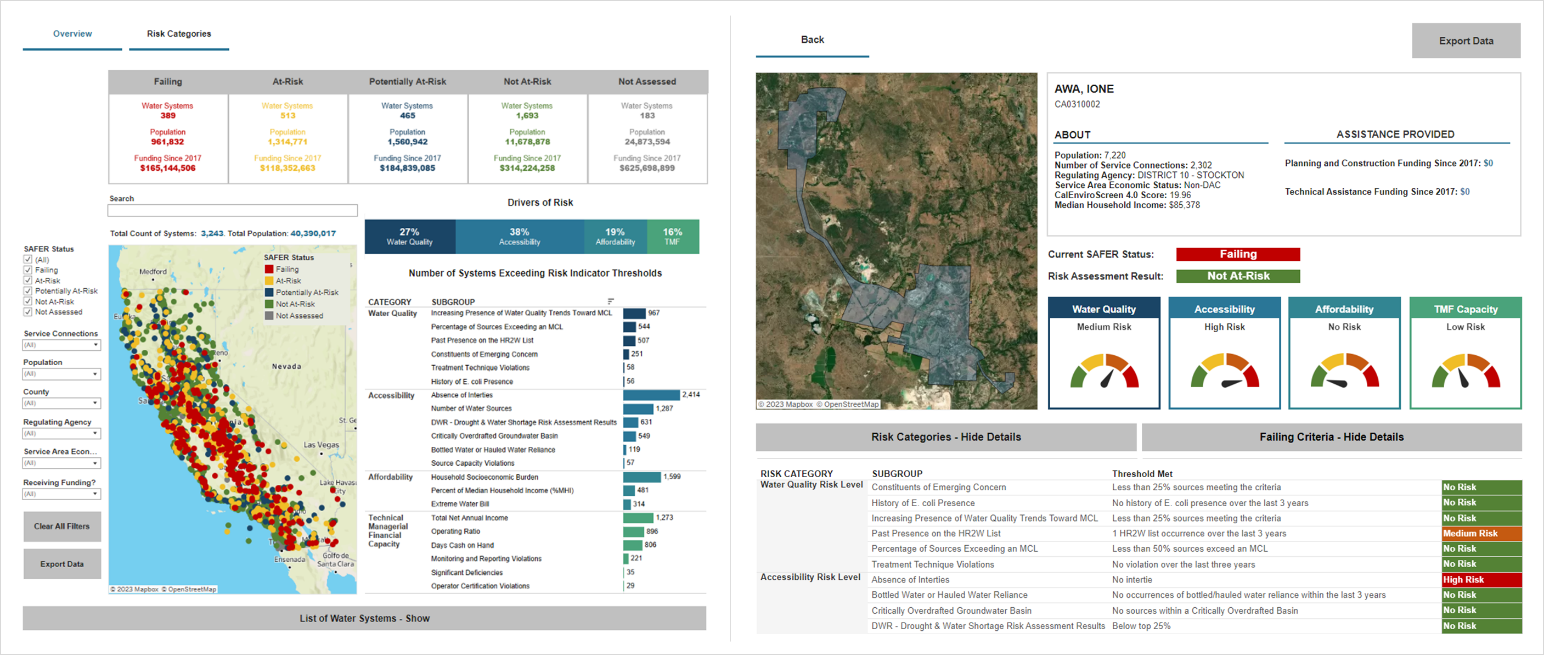 SAFER Dashboard Map
SAFER Dashboard Map
Risk Assessment for State Small Water Systems and Domestic Wells Dashboard
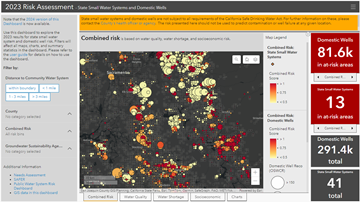 Risk Assessment for State Small Water Systems and Domestic Wells Dashboard
Risk Assessment for State Small Water Systems and Domestic Wells Dashboard
Quick Links
- Failing Criteria for Community Water Systems & Schools
- SAFER Dashboard (Failing & At-Risk Systems)
- State Small & Domestic Well Risk Assessment Results Dashboard
- Data.ca.gov Data Access
- Aquifer Risk Map
- Needs Assessment Water System Data Change Request Form
- Capacity Development
- SAFER Program
- SAFER Funding
- Human Right to Water Information
- Public Drinking Water General Information
- Dry Domestic (Private) Well Reporting System
- Public Water System Electronic Annual Report (eAR)
Contact
Needs Analysis Unit
DDW-SAFER-NAU@Waterboards.ca.gov
Language Access Services
To request services in any language, click on “Request Language Services” to open the language access form.
The form is available in English, Español (Spanish), Tagalog, 中文 (Simplified Chinese), 한국인 (Korean), Tiếng Việt (Vietnamese), ਪੰਜਾਬੀ (Punjabi).

